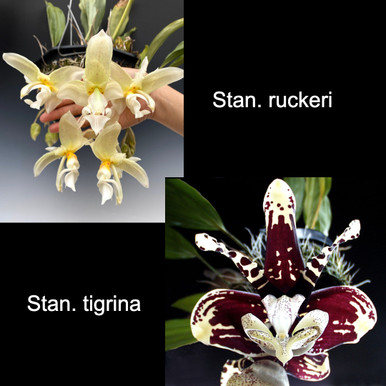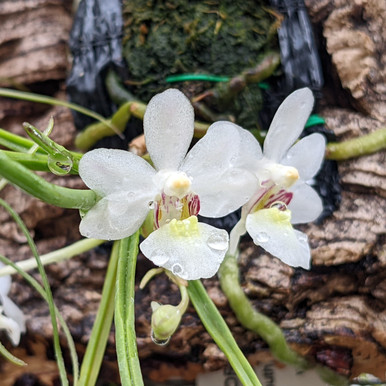Vanda Orchid Care
Vandas are native to Southeast Asia, where they have adapted to prefer bright light, warm temperatures, and high humidity. These plants are known for their large flower size and vibrant colors which can appear at any time of year! The heaviest flowering season is in summer, when the cooler temperatures and bright light of spring initiate flower spikes. Keep the mix moist when the plant initiates buds or starts flowering. If the top of the buds become glued together with a clear, honey-like substance, try misting the bulbs to dissolve this sugary secretion and they should open normally. Vanda flowers are large with thick substance, and can bloom for one to three months at a time.
Light and Shade
Most Vandas grow on treetops on ridges along rivers, where they have adapted to bright light conditions. When growing indoors, a south window exposure is best. Vandas can be grown outside as long as the night temperatures are 55°F (13°C) or above. When moving your Vandas outdoors, first grow them under dappled sunlight such as a shade tree or an evergreen, before gradually exposing to brighter light. If growing under lights, LED grow lights provide adequate light to promote flowering 2 to 3 times per year, provided the plant has reached a mature size. The artificial light market has expanded greatly in recent years, so a quick Google search will result in a variety of lighting options and price ranges.
Temperature and Humidity
Vandas thrive with a day temperature range between 70°F and 90°F (20°C to 32°C), with night temperatures between 60°F to 65°F (16°C to 18°C). Vandas benefit from humidity levels between 50% and 70%. If provided enough humidity, Vandas can be grown without any potting medium whatsoever. Many times Vandas will be shipped from overseas where they have been grown in high humidity environments, therefore being grown bare root in the basket. However, the typical household does not provide enough humidity to keep Vandas growing well in bare root condition. We recommend that you lightly pack New Zealand Sphagnum Moss around the roots to provide moisture to the roots. Humidity at home can be increased with the use of a humidifier or a humidity tray. Just make sure that the plant is not standing in water or the roots will rot.
Watering
If grown bare root, Vandas should be wetted or misted daily. For potted Vandas, plants should be watered just as the medium dries out and the media is lightly damp to the touch. This generally occurs every 5 to 7 days from the previous watering. If in doubt, do not water and wait another day or two. Remember that small plants in clay pots can dry out within a couple of days. Plants should never stand in water. Make sure to water more often when Vandas are about to bloom, and throughout the blooming period. When repotting your Vanda during the active growing season, do not water the media for at least 7 days. This allows cuts and breaks in the roots to callous and avoid rotting upon being watered. We always recommend watering in the morning, as this gives the leaves time to dry and avoid bacterial growth overnight. If possible, use water low in alkalinity, such as rainwater, distilled water, or reverse osmosis water. If you have a dehumidifier in your home, the water that collects in the tray is excellent for watering orchids.
Feeding
We highly recommend Green Jungle Orchid Food, specially formulated to provide orchids with the nutrients they would naturally encounter in their wild habitats. This is the fertilizer that we developed to use on our own plants in production, with excellent results for decades! This formula works best with water low in alkalinity (such as rainwater, distilled water, or reverse osmosis water). However, you may use tap water, keeping in mind that mineral buildup will require repotting more frequently, on the order of every 1 to 2 years. If potting in bark mix, fertilize every time you water during the growing season, flushing with non-softened water once a month. This rinses the media of salt and mineral buildup. During periods of inactive growth, fertilize every other watering. If potting in sphagnum moss, fertilize every 3rd watering year round.
Potting
Vandas can be grown in baskets or in pots. For most household conditions, pots are best because they hold more moisture around the roots. At Orchids Limited, we recommend potting Vandas using New Zealand Sphagnum Moss or the Medium grade of our Traditional Orchid Bark Mix. Large Vanda specimens should utilize the Large grade of our Traditional Orchid Bark Mix. Vandas should only be grown bare root when high humidity can be maintained, such as in greenhouses, growing chambers, or outdoors where they could be wetted or misted every day. In general, repotting should be done every 2 years. Repotting becomes necessary when the plant has outgrown its pot and the new roots reach out over the edge, or when the potting medium has broken down. When repotting, choose a pot 1/2" to 1" larger. Grab the plant near the base of the pot and start by gently, but firmly, pulling the plant out of its old pot. When growing in clay pots, it is sometimes easiest to simply take a hammer and break the clay pot. Do not worry about breaking or cracking roots, this will not harm the plant long term. If the mix is old, crumbly and sour, carefully remove the media and rinse the root system. Trim off any dead roots and dead leaves. Position the plant in the center of the new pot. Then, spreading the plant roots out, fill in the space with the potting medium. Press down firmly with each handful so that the plant does not wobble around. Build up the mix about a half-inch below the rim of the pot. If your newly potted plant is wobbly, you can use a ring support or rhizome clip to secure the plant.
To avoid the transfer of orchid diseases, it is standard procedure to sterilize all cutting and potting instruments before using them on a plant. This can be done by flaming pruning shears with a butane torch, or by spraying with rubbing alcohol and wiping with a clean paper towel.
Pest Control
The main pest that Vandas attract are mealybugs, which will hide in the axis where the leaf meets the stem. The best treatment for mealybug is either a homemade pesticide of 1:1 parts water & rubbing alcohol, with a few drops of dish soap added. Spray the plants every few days, washing off the dead bugs in between. For large outbreaks, an application of a specially formulated pesticide spray every few days is more effective.
Featured Products
Shop all →





